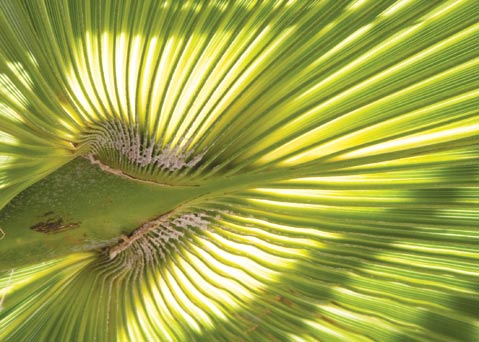Palm Trees: Part II
The Frond-Fringed Plant Grows Well in S.B.

There are many palms that take to the local climate quite happily. An iconic part of the Santa Barbara skyline is the Mexican fan palm, Washingtonia robusta. Its close relative and a native of California, the California fan palm, W. filifera, tower over one of the most popular beaches, East Beach and Cabrillo Boulevard. The earliest plantings of these palms dates to the 1890s, and the city parks department has continued to replace them as they age.
Both of these species grow in streambeds in the Palm Desert area or Baja California (Mexico). Some of their water courses have year-round water at the surface, but others are reduced to underground streams for most or all of the year. The sight of these stately palms rising out of the desert is magical, and the groves are easily reached on short hikes off the main roads.
Among other imports from points south is the Mexican blue palm, Brahea armata. This palm is quite slow-growing, but the silvery blue of its foliage is striking and very desirable in the landscape. There are a couple of other braheas that thrive here. The Guadalupe palm (B. edulis) is endemic (meaning it grows nowhere else on earth) to the tiny offshore island of Guadalupe. Its seeds germinate readily, and it seems to enjoy the mainland environment, which is good, since it has been nearly eradicated from its island home by the introduction of goats by the early Spaniards. The goats are now gone, and it is hoped that the palms can repopulate their native home. Two other palms in this genus are the San Jose hesper palm, B. brandegeei, and the Franceschi palm, B. elegans, both a little harder to find, but very adaptable and handsome garden palms.
Another commonly sighted palm is Chamaerops humilis, the Mediterranean fan palm. It is the hardiest of all the previously mentioned species and has survived temperatures as low as zero degrees Fahrenheit. It also is a clumping palm, meaning that it forms multiple stems from its underground crown and can serve as an impenetrable barrier when planted in a row or shine as a handsome single specimen. The individual stems of this palm rarely reach 20 feet in height, so it can become the perfect focal point even in smaller urban gardens.
Similar in appearance to the former is the windmill palm, Trachycarpus fortunei, from China. It has a slender trunk that retains the furry fibrous coating that grows with each frond and grows to a tidy and moderate size.
The lofty fishtail palms (Caryota species) bring a truly tropical flair to the landscape but are surprisingly drought-tolerant once they are established with regular, minimal watering. C. ochlandra, C. urens, and C. gigas are the most commonly found. They grow fairly rapidly until they reach their mature height of 25 or more feet before they begin flowering. Large clusters of flowers form in the axils of each leaf. Starting at the lowest leaf, they mature in sequence up the trunk until the last one at the top of the palm matures. At this point, the palm will die. Luckily, this process may take decades, and the palm remains a fine garden specimen until almost the bitter end.



